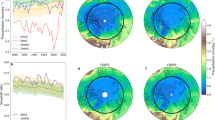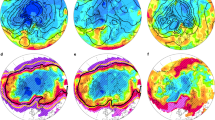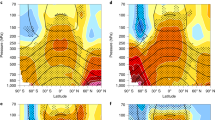Abstract
Precipitation changes projected for the end of the twenty-first century show an increase of more than 50 per cent in the Arctic regions1,2. This marked increase, which is among the highest globally, has previously been attributed primarily to enhanced poleward moisture transport from lower latitudes3,4. Here we use state-of-the-art global climate models5 to show that the projected increases in Arctic precipitation over the twenty-first century, which peak in late autumn and winter, are instead due mainly to strongly intensified local surface evaporation (maximum in winter), and only to a lesser degree due to enhanced moisture inflow from lower latitudes (maximum in late summer and autumn). Moreover, we show that the enhanced surface evaporation results mainly from retreating winter sea ice, signalling an amplified Arctic hydrological cycle. This demonstrates that increases in Arctic precipitation are firmly linked to Arctic warming and sea-ice decline. As a result, the Arctic mean precipitation sensitivity (4.5 per cent increase per degree of temperature warming) is much larger than the global value (1.6 to 1.9 per cent per kelvin). The associated seasonally varying increase in Arctic precipitation is likely to increase river discharge6,7,8 and snowfall over ice sheets9 (thereby affecting global sea level), and could even affect global climate through freshening of the Arctic Ocean and subsequent modulations of the Atlantic meridional overturning circulation10,11.
This is a preview of subscription content, access via your institution
Access options
Subscribe to this journal
Receive 51 print issues and online access
$199.00 per year
only $3.90 per issue
Buy this article
- Purchase on Springer Link
- Instant access to full article PDF
Prices may be subject to local taxes which are calculated during checkout




Similar content being viewed by others
References
Kattsov, V. M. et al. Simulation and projection of Arctic freshwater budget components by the IPCC AR4 global climate models. J. Hydrometeorol. 8, 571–589 (2007)
Collins, M. et al. in Climate Change 2013: The Physical Science Basis. Contribution of Working Group I to the Fifth Assessment Report of the Intergovernmental Panel on Climate Change (eds Stocker, T. F. et al.) 1029–1136 (Cambridge Univ. Press, 2013)
Kug, J. S. et al. Role of synoptic eddy feedback on polar climate responses to the anthropogenic forcing. Geophys. Res. Lett. 37, L14704 (2010)
Bengtsson, L. et al. The changing atmospheric water cycle in polar regions in a warmer climate. Tellus A 63, 907–920 (2011)
Taylor, K. E., Stouffer, R. J. & Meehl, G. A. An overview of CMIP5 and the experiment design. Bull. Am. Meteorol. Soc. 93, 485–498 (2012)
Peterson, B. J. et al. Increasing river discharge to the Arctic Ocean. Science 298, 2171–2173 (2002)
Holland, M. M., Finnis, J. & Serreze, M. C. Simulated Arctic Ocean freshwater budgets in the twentieth and twenty-first centuries. J. Clim. 19, 6221–6242 (2006)
Zhang, X. et al. Enhanced poleward moisture transport and amplified northern high-latitude wetting trend. Nature Clim. Change 3, 47–51 (2013)
Singarayer, J. S., Bamber, J. L. & Valdes, P. J. Twenty-first-century climate impacts from a declining Arctic sea ice cover. J. Clim. 19, 1109–1125 (2006)
Kattsov, V. M. & Walsh, J. E. Twentieth-century trends of Arctic precipitation from observational data and a climate model simulation. J. Clim. 13, 1362–1370 (2000)
Davies, F. J., Renssen, H. & Goosse, H. The Arctic freshwater cycle during a naturally and an anthropogenically induced warm climate. Clim. Dyn. 42, 2099–2112 (2014)
Held, I. M. & Soden, B. J. Robust responses of the hydrological cycle to global warming. J. Clim. 19, 5686–5699 (2006)
Stephens, G. L. & Ellis, T. D. Controls of global-mean precipitation increases in global warming GCM experiments. J. Clim. 21, 6141–6155 (2008)
Screen, J. A. & Simmonds, I. Declining summer snowfall in the Arctic: causes, impacts and feedbacks. Clim. Dyn. 38, 2243–2256 (2012)
Min, S. K., Zhang, X. & Zwiers, F. Human-induced Arctic moistening. Science 320, 518–520 (2008)
Walsh, J. E. et al. Arctic precipitation and evaporation: model results and observational estimates. J. Clim. 11, 72–87 (1998)
Liu, J. et al. Impact of declining Arctic sea ice on winter snowfall. Proc. Natl Acad. Sci. USA 109, 4074–4079 (2012)
Bintanja, R. et al. Important role for ocean warming and increased ice-shelf melt in Antarctic sea-ice expansion. Nature Geosci. 6, 376–379 (2013)
Holland, M. M. et al. Projected changes in Arctic Ocean freshwater budgets. J. Geophys. Res. 112, G04S55 (2007)
Cai, M. Dynamical amplification of polar warming. Geophys. Res. Lett. 32, L22710 (2005)
Alexeev, V. A., Langen, P. L. & Bates, J. R. Polar amplification of surface warming on an aquaplanet in ‘ghost forcing’ experiments without sea ice feedbacks. Clim. Dyn. 24, 655–666 (2005)
Francis, J. A. et al. An arctic hydrologic system in transition: feedbacks and impacts on terrestrial, marine, and human life. J. Geophys. Res. 114, G04019 (2009)
ACIA. Arctic Climate Impact Assessment (Cambridge Univ. Press, 2005)
Walsh, J. E. in The Freshwater Budget of the Arctic Ocean 21–43 (eds Lewis, E. L. et al.) (Kluwer, 2000)
Kurita, N. Origin of Arctic water vapor during the ice-growth season. Geophys. Res. Lett. 38, L02709 (2011)
Bintanja, R., Graversen, R. G. & Hazeleger, W. Arctic winter warming amplified by the thermal inversion and consequent low infrared cooling to space. Nature Geosci. 4, 758–761 (2011)
Barry, R. G. & Serreze, M. C. in The Freshwater Budget of the Arctic Ocean 45–56 (eds Lewis, E. L. et al.) (Kluwer, 2000)
Bintanja, R., van der Linden, E. C. & Hazeleger, W. Boundary layer stability and Arctic climate change: a feedback study using EC-Earth. Clim. Dyn. 39, 2659–2673 (2012)
Bintanja, R. & van der Linden, E. C. The changing seasonal climate in the Arctic. Sci. Rep. 3, 1556 (2013)
Hazeleger, W. et al. EC-Earth: a seamless Earth system prediction approach in action. Bull. Am. Meteorol. Soc. 91, 1357–1363 (2010)
Acknowledgements
We acknowledge the World Climate Research Programme's Working Group on Coupled Modelling, which is responsible for CMIP, and we thank all climate-modelling groups for producing and making available their model output. For CMIP the US Department of Energy’s Program for Climate Model Diagnosis and Intercomparison provides coordinating support and led the development of software infrastructure in partnership with the Global Organization for Earth System Science Portals. We are grateful to the EC-Earth consortium for their contribution to the development of the Earth System Model EC-Earth. We thank C. A. Katsman and R. G. Graversen for their comments on the manuscript, and to G. J. van Oldenborgh for information on intermodel versus intramodel climate variability.
Author information
Authors and Affiliations
Contributions
R.B. developed the ideas that led to this paper. R.B. and F.M.S. analysed the climate model simulations. R.B. wrote the main paper, with input from F.M.S. Both authors discussed the results and implications and commented on the manuscript at all stages.
Corresponding author
Ethics declarations
Competing interests
The authors declare no competing financial interests.
Extended data figures and tables
Extended Data Figure 1 Schematic overview of the main processes discussed in the paper.
Blue arrows denote future changes in the Arctic various moisture fluxes, with the size of the arrows loosely depicting the magnitude of the changes. The red text and arrows represent the associated climatic consequences.
Extended Data Figure 2 Number of CMIP5 models that simulate specific amounts of precipitation, surface evaporation and moisture transport across 60°N.
Distributions of Arctic (60°–90° N) precipitation (a), surface evaporation (b) and poleward moisture transport across 60° N (c) in terms of the number of CMIP5 models that simulate a specific amount. Distributions are given for the present (green), future RCP4.5 (red) and future RCP8.5 (blue). Dashed lines denote the model-mean values, while the purple line shows the present-day value derived from reanalyses data4.
Extended Data Figure 3 Simulated twenty-first-century changes in sea surface salinity in the Arctic Ocean north of 70° N.
Results are shown for the intermediate forcing scenario (RCP4.5) (a) and the strong forcing (RCP8.5) (b), sorted according to the magnitude of the change. The dashed line shows the multimodel-mean value. The salinity is shown on the colour scale in practical salinity units (PSU).
Extended Data Figure 4 Simulated changes in sea surface salinity resulting from a 50% increase in precipitation over the Arctic Ocean north of 70° N using the global climate model EC-Earth30.
The salinity change is shown on the colour scale in PSU.
Extended Data Figure 5 Simulated change in Arctic mean sea surface salinity against the ratio of changes in moisture transport across 70° N and surface evaporation.
The ratio is equivalent to the ratio of remote and local contributions. Each square represents one CMIP5 model. The straight line shows the best linear fit to the data, where R is the correlation coefficient and p is the probability that uncorrelated data of the same sample size would yield a similar relationship.
Extended Data Figure 6 Simulated AMOC strength as a function of Arctic precipitation increase.
Time series of simulated annual-mean AMOC strength at 30° N for the various Arctic precipitation (P) change simulations (see main text for details) carried out with the global climate model EC-Earth30.
Rights and permissions
About this article
Cite this article
Bintanja, R., Selten, F. Future increases in Arctic precipitation linked to local evaporation and sea-ice retreat. Nature 509, 479–482 (2014). https://doi.org/10.1038/nature13259
Received:
Accepted:
Published:
Issue Date:
DOI: https://doi.org/10.1038/nature13259
This article is cited by
-
Evidence of human influence on Northern Hemisphere snow loss
Nature (2024)
-
Validation of key Arctic energy and water budget components in CMIP6
Climate Dynamics (2024)
-
Continentality determines warming or cooling impact of heavy rainfall events on permafrost
Nature Communications (2023)
-
Arctic cyclones have become more intense and longer-lived over the past seven decades
Communications Earth & Environment (2023)
-
Seasonally distinct contributions of greenhouse gases and anthropogenic aerosols to historical changes in Arctic moisture budget
npj Climate and Atmospheric Science (2023)
Comments
By submitting a comment you agree to abide by our Terms and Community Guidelines. If you find something abusive or that does not comply with our terms or guidelines please flag it as inappropriate.



